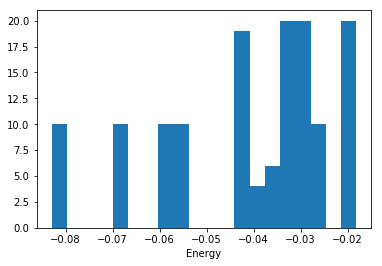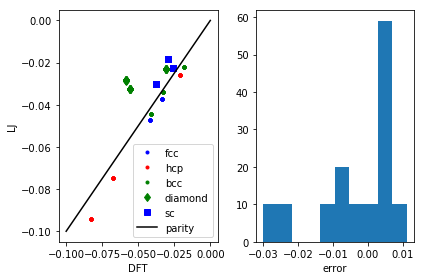More auto-differentiation goodness for science and engineering
Posted November 22, 2017 at 03:52 PM | categories: autograd, python | tags:
Updated November 22, 2017 at 03:55 PM
Table of Contents
In this post I continue my investigations in the use of auto-differentiation via autograd in scientific and mathematical programming. The main focus of today is using autograd to get derivatives that either have mathematical value, eg. accelerating root finding, or demonstrating mathematical rules, or scientific value, e.g. the derivative is related to a property, or illustrates some constraint.
All the code in this post relies on these imports:
import autograd.numpy as np from autograd import grad, jacobian
In the following sections I explore some applications in calculus, root-finding, materials and thermodynamics.
1 Showing mixed partial derivatives are equal
In calculus, we know that if we have a well-behaved function \(f(x, y)\), then it should be true that \(\frac{\partial^2f}{\partial x \partial y} = \frac{\partial^2f}{\partial y \partial y}\).
Here we use autograd to compute the mixed partial derivatives and show for 10 random points that this statement is true. This doesnt' prove it for all points, of course, but it is easy to prove for any point of interest.
def f(x, y): return x * y**2 dfdx = grad(f) d2fdxdy = grad(dfdx, 1) dfdy = grad(f, 1) d2fdydx = grad(dfdy) x = np.random.rand(10) y = np.random.rand(10) T = [d2fdxdy(x1, y1) == d2fdydx(x1, y1) for x1, y1 in zip(x, y)] print(np.all(T))
True
2 Root finding with jacobians
fsolve often works fine without access to derivatives. In this example from here, we solve a set of equations with two variables, and it takes 21 iterations to reach the solution.
from scipy.optimize import fsolve def f(x): return np.array([x[1] - 3*x[0]*(x[0]+1)*(x[0]-1), .25*x[0]**2 + x[1]**2 - 1]) ans, info, flag, msg = fsolve(f, (0.5, 0.5), full_output=1) print(ans) print(info['nfev'])
[ 1.117 0.83 ] 21
If we add the jacobian, we get the same result with only 15 iterations, about 1/3 fewer iterations. If the iterations are expensive, this might save a lot of time.
df = jacobian(f) x0 = np.array([0.5, 0.5]) ans, info, flag, msg = fsolve(f, x0, fprime=df, full_output=1) print(ans) print(info['nfev'])
[ 1.117 0.83 ] 15
There is a similar example provided by autograd.
3 Getting the pressure from a solid equation of state
In this post we described how to fit a solid equation of state to describe the energy of a solid under isotropic strain. Now, we can readily compute the pressure at a particular volume from the equation:
\(P = -\frac{dE}{dV}\)
We just need the derivative of this equation:
\(E = E_0+\frac{B_0 V}{B'_0}\left[\frac{(V_0/V)^{B'_0}}{B'_0-1}+1\right]-\frac{V_0 B_0}{B'_0-1}\)
or we use autograd to get it for us.
E0, B0, BP, V0 = -56.466, 0.49, 4.753, 16.573 def Murnaghan(vol): E = E0 + B0 * vol / BP * (((V0 / vol)**BP) / (BP - 1.0) + 1.0) - V0 * B0 / (BP - 1.) return E def P(vol): dEdV = grad(Murnaghan) return -dEdV(vol) * 160.21773 # in Gpa print(P(V0)) # Pressure at the minimum print(P(0.99 * V0)) # Compressed
4.44693531998e-15 0.808167684691
So it takes positive pressure to compress the system, as expected, and at the minimum the pressure is equal to zero. Seems pretty clear autograd is better than deriving the required pressure derivative.
4 Deriving activity coefficients and demonstration of the Gibbs-Duhem relation
Thermodynamics tells us that in a binary mixture the following is true:
\(0 = x_1 \frac{d \ln \gamma_1}{dx_1} + (1 - x_1) \frac{d \ln \gamma_2}{dx_1}\)
In other words, the activity coefficients of the two species can't be independent.
Suppose we have the Margules model for the excess free energy:
\(G^{ex}/RT = n x_1 (1 - x_1) (A_{21} x_1 + A_{12} (1 - x_1))\)
where \(n = n_1 + n_2\), and \(x_1 = n1 / n\), and \(x_2 = n_2 / n\).
From this expression, we know:
\(\ln \gamma_1 = \frac{\partial G_{ex}/RT}{\partial n_1}\)
and
\(\ln \gamma_2 = \frac{\partial G_{ex}/RT}{\partial n_2}\)
It is also true that (the Gibbs-Duhem equation):
\(0 = x_1 \frac{d \ln \gamma_1}{d n_1} + x_2 \frac{d \ln \gamma_2}{d n_1}\)
Here we will use autograd to get these derivatives, and demonstrate the Gibbs-Duhem eqn holds for this excess Gibbs energy model.
A12, A21 = 2.04, 1.5461 # Acetone/water https://en.wikipedia.org/wiki/Margules_activity_model def GexRT(n1, n2): n = n1 + n2 x1 = n1 / n x2 = n2 / n return n * x1 * x2 * (A21 * x1 + A12 * x2) lngamma1 = grad(GexRT) # dGex/dn1 lngamma2 = grad(GexRT, 1) # dGex/dn2 n1, n2 = 1.0, 2.0 n = n1 + n2 x1 = n1 / n x2 = n2 / n # Evaluate the activity coefficients print('AD: ',lngamma1(n1, n2), lngamma2(n1, n2)) # Compare that to these analytically derived activity coefficients print('Analytical: ', (A12 + 2 * (A21 - A12) * x1) * x2**2, (A21 + 2 * (A12 - A21) * x2) * x1**2) # Demonstration of the Gibbs-Duhem rule dg1 = grad(lngamma1) dg2 = grad(lngamma2) n = 1.0 # Choose a basis number of moles x1 = np.linspace(0, 1) x2 = 1 - x1 n1 = n * x1 n2 = n - n1 GD = [_x1 * dg1(_n1, _n2) + _x2 * dg2(_n1, _n2) for _x1, _x2, _n1, _n2 in zip(x1, x2, n1, n2)] print(np.allclose(GD, np.zeros(len(GD))))
('AD: ', 0.76032592592592585, 0.24495925925925932)
('Analytical: ', 0.760325925925926, 0.24495925925925924)
True
That is pretty compelling. The autograd derivatives are much easier to code than the analytical solutions (which also had to be derived). You can also see that the Gibbs-Duhem equation is satisfied for this model, at least with a reasonable tolerance for the points we evaluated it at.
5 Summary
Today we examined four ways to use autograd in scientific or mathematical programs to replace the need to derive derivatives by hand. The main requirements for this to work are that you use the autograd.numpy module, and only the functions in it that are supported. It is possible to add your own functions (described in the tutorial) if needed. It seems like there are a lot of opportunities for scientific programming for autograd.
Copyright (C) 2017 by John Kitchin. See the License for information about copying.
Org-mode version = 9.1.2




